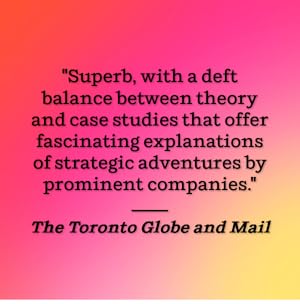Customer Services
Copyright © 2025 Desertcart Holdings Limited
Desert Online General Trading LLC
Dubai, United Arab Emirates


Full description not available



B**N
The 80/20 principle applied to business analysis
Carefully read the first half of this book a couple times and you can expect to deeply internalize the most general, enduring principles of analyzing competitive advantage and entry barriers.This book's value is its simplicity. There's nothing groundbreaking here. Greenwald's got no axe to grind, no TED-talk tailored concept to (over) sell. The ratio of insight to fluff is very high, so you'll actually remember what you read.Non-practitioner's won't grasp how valuable a simple, deeply internalized analysis framework is. Researching a company you know nothing about- cracking open a fresh 10-K - can be overwhelming. A simple framework focuses your attention, let's you filter out the noise, and zoom in on the pertinent.Porter's five forces isn't wrong, it's just excessive and distracting. Sure, it's nice for an MBA assignment: go analyze company X on these five dimensions. But if the lesson learned is that equal effort should be expended analyzing "supplier power" as "entry barriers", then the student has been deceived.Scholars love excessive complication. I recall the corporate finance section of the CFA exam, wherein project go/no-go decisions depend on said project's stock market Beta, with calculations carried out to the decimal point. All this "rigor" for calculating project discount rates despite the empirical fact that Beta doesn't work. It's not just slightly wrong. It gets the *sign* of the covariance-return relationship wrong. Amazing.My point is that Greenwald runs counter this tendency. He cuts away the baloney, ignores the auxiliary, and solidifies the foundation of competitive analysis.*The second half of the book, which deals with strategic interaction, isn't vital. It feels like Greenwald threw it in because his publisher wanted a longer book.
I**I
Good information
I came across Greenwald's other works and decided to give this a shot. From the perspective of an investor, the entire book is not totally "a must read." It certainly was worth reading and it will be valuable to analyze companies with the book's general ideas in mind. I was looking for a book that would help me find and analyze a company's competitive position better. This book did just that. B-
J**P
An excellent and interesting book
I bought this book after seeing that it was one of two textbooks for Columbia University's Security Analysis course. (The other textbook is the 1988 edition of Security Analysis.) Apparently the author of Competition Demystified, Bruce Greenwald, used to teach the class. The course readings from this book were pages 1-77, 160-181, 220-238, and 322-363.The book is primarily about how investors can identify, and how businesses can establish & defend, a sustainable competitive advantage (i.e. a wide economic moat). Greenwald and Kahn obviously come from the Graham/Buffett style of investing.
C**A
Very valuable
This book delves into competitive advantages, specifically looking at barriers to entry. Although the author acknowledges Michael Porter's work on competition as being invaluable, the author isolates barriers to entry as the single most important driver of an industry's competitive structure. There are numerous case studies which are very instructive and informative.The only thing I would say that would give more insight would be to provide some framework for doing this analysis yourself. While I can fully grasp his analysis and conclusions, I don't believe there is sufficient information to help the reader to any of their own industry analysis (although that was not likely the scope of the book anyway).
M**C
One of the Best Books for Assessing Corporate Strategy from an Investor's Perspective
Greenwald and Kahn have done a masterful job at providing simple but extremely useful mental models for assessing corporate strategy. Anyone who wants to learn more about corporate strategy would be wise to read this book. Far more simple and therefore useful than Michael Porter's Five Forces model.
J**S
Gets to the point quickly
This book cuts through the 5 steps and gets to the most important point of competitive analysis - Barriers to Entry. Also has good examples of how to apply the analysis, but doesn't take it to a pragmatic level.
A**N
Financial Masterpiece
This is the best book on marketing I have ever read. It completely broadens one's thinking beyond the basics of brand recognition and product advertising. With numerous case studies ranging from the PC industry to the creation of CDs to Rupert Murdoch's decision to Create the Fox Television Network, the book presents thorough leasons in business alchemy in a highly readable fashion.
K**F
A guide to becoming a strategist
My two key takeaways from reading Greenwald's well-argued and counterintuitive premise are:1. There are but a few fundamental sources of competitive advantage2. Most companies can tap these sources at a local level (not a national or international level)These show that the front-line manager - the regional coordinator of retail chain or the country manager of service firm - has the power (and the obligation) to pursue local competitive advantages. Greenwald provides a simple, intuitive method for helping such "front-line strategists" seek out a competitive edge.I recommend this highly for anyone who aspires to be a strategist.
Trustpilot
2 weeks ago
1 month ago